Evaluation and Projection of Degree-Days and Degree-Days Categories in Southeast Europe Using EURO-CORDEX
Abstract
1. Introduction
2. Study Area and Used Data
2.1. Study Area, Meteorological Data and Scenarios
2.2. Meteorological Data and Scenarios
3. Methodology and Computations
4. Results and Discussion
4.1. Evaluation of Historical Experiments
4.2. Projections of Future Changes
5. Conclusions and Outlook
Author Contributions
Funding
Institutional Review Board Statement
Informed Consent Statement
Data Availability Statement
Acknowledgments
Conflicts of Interest
Abbreviations
| AB | Absolute Bias |
| AR5 | Fifth Assessment Report (of the IPCC) |
| C3S | Copernicus Climate Change Service |
| CCDD | Cooling Degree-day |
| CDS | Climate Data Store (of the Copernicus Climate Change Service) |
| CMIP5 | Coupled Model Intercomparison Project Phase 5 |
| DDC | Degrree-day Category |
| ECMWF | European Centre for Medium-Range Weather Forecasts |
| GCM | Global Circulation Model |
| HHDD | Heating Degree-day |
| HVAC | Heating, Ventilating, and Air-conditioning |
| IPCC | Intergovernmental Panel on Climate Change |
| MCD | Mostly Cold Day |
| MME | Multimodel ensemble |
| MWD | Mostly Warm Day |
| RCM | Regional Climate Model |
| RCP | Representative Concentration Pathway |
| SEEu | Southeast Europe |
| UCD | Uniformly Cold Day |
| UKMO | United Kingdom Meteorological Office |
| UWD | Uniformly Warm Day |
References
- IPCC. Summary for Policymakers. In Climate Change 2023: Synthesis Report. Contribution of Working Groups I, II and III to the Sixth Assessment Report of the Intergovernmental Panel on Climate Change; IPCC: Geneva, Switzerland, 2023; pp. 1–34. [Google Scholar] [CrossRef]
- Lionello, P.; Abrantes, F.; Congedi, L.; Dulac, F.; Gacic, M.; Gomis, D.; Goodess, C.; Hoff, H.; Kutiel, H.; Luterbacher, J.; et al. Introduction: Mediterranean Climate—Background Information. In The Climate of the Mediterranean Region; Elsevier Inc.: Amsterdam, The Netherlands, 2012; pp. 35–90. [Google Scholar] [CrossRef]
- Xoplaki, E.; Trigo, R.M.; García-Herrera, R.; Barriopedro, D.; D’Andrea, F.; Fischer, E.M.; Gimeno, L.; Gouveia, C.; Hernández, E.; Kuglitsch, F.G.; et al. Large-Scale Atmospheric Circulation Driving Extreme Climate Events in the Mediterranean and Its Related Impacts. In The Climate of the Mediterranean Region; Elsevier Inc.: Amsterdam, The Netherlands, 2012; pp. 347–417. [Google Scholar] [CrossRef]
- Andrade, C.; Mourato, S.; Ramos, J. Heating and Cooling Degree-Days Climate Change Projections for Portugal. Atmosphere 2021, 12, 715. [Google Scholar] [CrossRef]
- Salata, F.; Falasca, S.; Ciancio, V.; Curci, G.; de Wilde, P. Climate-Change Related Evolution of Future Building Cooling Energy Demand in a Mediterranean Country. Energy Build. 2023, 290, 113112. [Google Scholar] [CrossRef]
- Pangsy-Kania, S.; Biegańska, J.; Flouros, F.; Sokół, A. Heating and Cooling Degree-Days vs Climate Change in Years 1979–2021. Evidence from the European Union and Norway. Econ. Environ. 2024, 88, 619. [Google Scholar] [CrossRef]
- Mehregan, M.; Naminezhad, A.; Vakili, S.; Delpisheh, M. Building Energy Model Validation and Estimation Using Heating and Cooling Degree Days (HDD–CDD) Based on Accurate Base Temperature. Energy Sci. Eng. 2022, 10, 3638–3649. [Google Scholar] [CrossRef]
- Larsen, M.A.D.; Petrović, S.; Radoszynski, A.M.; McKenna, R.; Balyk, O. Climate Change Impacts on Trends and Extremes in Future Heating and Cooling Demands over Europe. Energy Build. 2020, 226, 110397. [Google Scholar] [CrossRef]
- Petri, Y.; Caldeira, K. Impacts of Global Warming on Residential Heating and Cooling Degree-Days in the United States. Sci. Rep. 2015, 5, 12427. [Google Scholar] [CrossRef]
- Buonocore, J.J.; Salimifard, P.; Magavi, Z.; Allen, J.G. Inefficient Building Electrification Will Require Massive Buildout of Renewable Energy and Seasonal Energy Storage. Sci. Rep. 2022, 12, 11931. [Google Scholar] [CrossRef]
- Lyu, J.; Ono, T.; Sato, A.; Hagishima, A.; Tanimoto, J. Seasonal Variation of Residential Cooling Use Behaviour Derived from Energy Demand Data and Stochastic Building Energy Simulation. J. Build. Eng. 2022, 49, 104067. [Google Scholar] [CrossRef]
- Mastrucci, A.; van Ruijven, B.; Byers, E.; Poblete-Cazenave, M.; Pachauri, S. Global Scenarios of Residential Heating and Cooling Energy Demand and CO2 Emissions. Clim. Change 2021, 168, 14. [Google Scholar] [CrossRef]
- Spinoni, J.; Vogt, J.V.; Barbosa, P.; Dosio, A.; McCormick, N.; Bigano, A.; Füssel, H. Changes of Heating and Cooling Degree-days in Europe from 1981 to 2100. Int. J. Climatol. 2017, 38, e191–e208. [Google Scholar] [CrossRef]
- Filahi, H.; Omrani, H.; Claudel, S.; Drobinski, P. Temporal Fragmentation of the Energy Demand in Europe: Impact of Climate Change on the Maneuverability of Energy System. Clim. Serv. 2024, 34, 100469. [Google Scholar] [CrossRef]
- Pérez-Andreu, V.; Aparicio-Fernández, C.; Martínez-Ibernón, A.; Vivancos, J.-L. Impact of Climate Change on Heating and Cooling Energy Demand in a Residential Building in a Mediterranean Climate. Energy 2018, 165, 63–74. [Google Scholar] [CrossRef]
- Skarbit, N.; Unger, J.; Gál, T. Projected Values of Thermal and Precipitation Climate Indices for the Broader Carpathian Region Based on EURO-CORDEX Simulations. Hung. Geogr. Bull. 2022, 71, 325–347. [Google Scholar] [CrossRef]
- Badescu, V.; Zamfir, E. Degree-Days, Degree-Hours and Ambient Temperature Bin Data from Monthly-Average Temperatures (Romania). Energy Convers. Manag. 1999, 40, 885–900. [Google Scholar] [CrossRef]
- Karagiannids, A.; Lagouvardos, K.; Kotroni, V.; Galanaki, E. Analysis of Current and Future Heating and Cooling Degree Days over Greece Using Observations and Regional Climate Model Simulations. Environ. Sci. Proc. 2023, 26, 149. [Google Scholar] [CrossRef]
- Tringa, E.; Tolika, K.; Tsoka, S.; Anagnostopoulou, C.; Kostopoulou, E. Assessing Future Changes in Heating and Cooling Degree Days Using Multiple Base Temperatures for Cultural Heritage Sites in Greece: A Case Study of Thessaloniki and Delphi. Sci. Total Environ. 2025, 977, 179352. [Google Scholar] [CrossRef]
- Büyükalaca, O.; Bulut, H.; Yılmaz, T. Analysis of Variable-Base Heating and Cooling Degree-Days for Turkey. Appl. Energy 2001, 69, 269–283. [Google Scholar] [CrossRef]
- Yildiz, I.; Sosaoglu, B. Spatial Distributions of Heating, Cooling, and Industrial Degree-Days in Turkey. Theor. Appl. Climatol. 2007, 90, 249–261. [Google Scholar] [CrossRef]
- Janković, A.; Podraščanin, Z.; Djurdjevic, V. Future Climate Change Impacts on Residential Heating and Cooling Degree Days in Serbia. IDŐJÁRÁS 2019, 123, 351–370. [Google Scholar] [CrossRef]
- Spinoni, J.; Vogt, J.; Barbosa, P. European Degree-day Climatologies and Trends for the Period 1951–2011. Int. J. Climatol. 2014, 35, 25–36. [Google Scholar] [CrossRef]
- Ürge-Vorsatz, D.; Khosla, R.; Bernhardt, R.; Chan, Y.C.; Vérez, D.; Hu, S.; Cabeza, L.F. Advances Toward a Net-Zero Global Building Sector. Annu. Rev. Environ. Resour. 2020, 45, 227–269. [Google Scholar] [CrossRef]
- Giorgi, F.; Mearns, L.O. Approaches to the Simulation of Regional Climate Change: A Review. Rev. Geophys. 1991, 29, 191–216. [Google Scholar] [CrossRef]
- Kotlarski, S.; Keuler, K.; Christensen, O.B.; Colette, A.; Déqué, M.; Gobiet, A.; Goergen, K.; Jacob, D.; Lüthi, D.; van Meijgaard, E.; et al. Regional Climate Modeling on European Scales: A Joint Standard Evaluation of the EURO-CORDEX RCM Ensemble. Geosci. Model Dev. 2014, 7, 1297–1333. [Google Scholar] [CrossRef]
- Sillmann, J.; Kharin, V.V.; Zwiers, F.W.; Zhang, X.; Bronaugh, D. Climate Extremes Indices in the CMIP5 Multimodel Ensemble: Part 2. Future Climate Projections. J. Geoph. Res. Atmos. 2013, 118, 2473–2493. [Google Scholar] [CrossRef]
- Merrifield, A.L.; Brunner, L.; Lorenz, R.; Medhaug, I.; Knutti, R. An Investigation of Weighting Schemes Suitable for Incorporating Large Ensembles into Multi-Model Ensembles. Earth Sys. Dyn. 2020, 11, 807–834. [Google Scholar] [CrossRef]
- Herger, N.; Abramowitz, G.; Knutti, R.; Angélil, O.; Lehmann, K.; Sanderson, B.M. Selecting a Climate Model Subset to Optimise Key Ensemble Properties. Earth Sys. Dyn. 2018, 9, 135–151. [Google Scholar] [CrossRef]
- Chervenkov, H.; Slavov, K. Population-Weighted Degree-Days over Southeast Europe—Near Past Climate Evaluation and Future Projections with NEX-GDDP CMIP6 Ensemble. Climate 2025, 13, 66. [Google Scholar] [CrossRef]
- Jacob, D.; Kotova, L.; Teichmann, C.; Sobolowski, S.P.; Vautard, R.; Donnelly, C.; Koutroulis, A.G.; Grillakis, M.G.; Tsanis, I.K.; Damm, A.; et al. Climate Impacts in Europe under +1.5 °C Global Warming. Earths Fut. 2018, 6, 264–285. [Google Scholar] [CrossRef]
- Berger, M.; Worlitschek, J. The Link between Climate and Thermal Energy Demand on National Level: A Case Study on Switzerland. Energy Build. 2019, 202, 109372. [Google Scholar] [CrossRef]
- Chervenkov, H.; Ivanov, V.; Gadzhev, G.; Ganev, K.; Melas, D. Degree-Day Climatology over Central and Southeast Europe for the Period 1961-2018 — Evaluation in High Resolution. Cybern. Inf. Technol. 2020, 20, 166–174. [Google Scholar] [CrossRef]
- Ivanov, V.; Chervenkov, H.; Gadzhev, G.; Ganev, K. Degree-days and agro-meteorological Indices in the Projected Future Climate over Southeast Europe. In Proceedings of the SGEM International Multidisciplinary Scientific GeoConference EXPO Proceedings, Albena, Bulgaria, 18–24 August 2020; Surveying Geology & Mining Ecology Management (SGEM): Albena, Bulgaria, 2020. [Google Scholar] [CrossRef]
- Chervenkov, H.; Gadzhev, G.; Ivanov, V.; Ganev, K. Degree-Days and Agro-Meteorological Indices in CMIP5 RCP8.5 Future Climate—Results for Central and Southeast Europe. Stud. Syst. Decis. Control 2021, 19–30. [Google Scholar] [CrossRef]
- Cramer, W.; Guiot, J.; Fader, M.; Garrabou, J.; Gattuso, J.-P.; Iglesias, A.; Lange, M.A.; Lionello, P.; Llasat, M.C.; Paz, S.; et al. Climate Change and Interconnected Risks to Sustainable Development in the Mediterranean. Nat. Clim. Chang. 2018, 8, 972–980. [Google Scholar] [CrossRef]
- Climate Data Store (CDS) of the Copernicus Climate Change Service (C3S). Available online: https://cds.climate.copernicus.eu/datasets/projections-cordex-domains-single-levels?tab=overview (accessed on 12 February 2024).
- Muñoz-Sabater, J.; Dutra, E.; Agustí-Panareda, A.; Albergel, C.; Arduini, G.; Balsamo, G.; Boussetta, S.; Choulga, M.; Harrigan, S.; Hersbach, H.; et al. ERA5-Land: A State-of-the-Art Global Reanalysis Dataset for Land Applications. Earth Syst. Sci. Data 2021, 13, 4349–4383. [Google Scholar] [CrossRef]
- Guo, C.; Ning, N.; Guo, H.; Tian, Y.; Bao, A.; De Maeyer, P. Does ERA5-Land Effectively Capture Extreme Precipitation in the Yellow River Basin? Atmosphere 2024, 15, 1254. [Google Scholar] [CrossRef]
- Jacob, D.; Petersen, J.; Eggert, B.; Alias, A.; Christensen, O.B.; Bouwer, L.M.; Braun, A.; Colette, A.; Déqué, M.; Georgievski, G.; et al. EURO-CORDEX: New High-Resolution Climate Change Projections for European Impact Research. Reg. Environ. Change 2014, 14, 563–578. [Google Scholar] [CrossRef]
- Kotova, L.; Leissner, J.; Winkler, M.; Kilian, R.; Bichlmair, S.; Antretter, F.; Moßgraber, J.; Reuter, J.; Hellmund, T.; Matheja, K.; et al. Making Use of Climate Information for Sustainable Preservation of Cultural Heritage: Applications to the KERES Project. Herit. Sci. 2023, 11, 18. [Google Scholar] [CrossRef]
- Thomson, A.M.; Calvin, K.V.; Smith, S.J.; Kyle, G.P.; Volke, A.; Patel, P.; Delgado-Arias, S.; Bond-Lamberty, B.; Wise, M.A.; Clarke, L.E.; et al. RCP4.5: A Pathway for Stabilization of Radiative Forcing by 2100. Clim. Change 2011, 109, 77–94. [Google Scholar] [CrossRef]
- Riahi, K.; Rao, S.; Krey, V.; Cho, C.; Chirkov, V.; Fischer, G.; Kindermann, G.; Nakicenovic, N.; Rafaj, P. RCP 8.5–A Scenario of Comparatively High Greenhouse Gas Emissions. Clim. Change 2011, 109, 33–57. [Google Scholar] [CrossRef]
- CIBSE TM41, 2006 (TM41: Degree Days: Theory & Application, by the Chartered Institution of Building Services Engineers (CIBSE). Available online: http://refhub.elsevier.com/S0048-9697(25)00988-X/rf0230 (accessed on 4 March 2024).
- Schulzweida, U. CDO User Guide (Version 2.0.0). 30 October 2020. Available online: https://zenodo.org/record/5614769#.Yk027ihBxPY (accessed on 23 February 2024).
- Chervenkov, H.; Spiridonov, V. Bias Correcting of Selected ETCCDI Climate Indices for Projected Future Climate. In Large-Scale Scientific Computing; Springer International Publishing: Cham, Switzerland, 2020; pp. 92–299. ISBN 9783030410315. [Google Scholar]
- Frasca, F.; Siani, A.M.; Bertolin, C. Energy Demand for Indoor Climate Control in Museums: Challenges and Perspectives in Time of a Changing Climate. Procedia Struct. Integr. 2024, 55, 32–38. [Google Scholar] [CrossRef]
- Eurostat, GEOSTAT—Eurostat, Geostat. 2016. Available online: https://ec.europa.eu/eurostat/web/gisco/geodata/reference-data/population-distribution-demography/geostat (accessed on 10 February 2024).
- Kyriakopoulos, P.; Giannopoulos, A.; Caouris, Y.G.; Souliotis, M.; Santamouris, M. Degree-Hours and Degree-Days in Coastal Mediterranean Cities, Patras and Kalamata, Greece. Adv. Environ. Eng. Res. 2021, 2, 1. [Google Scholar] [CrossRef]

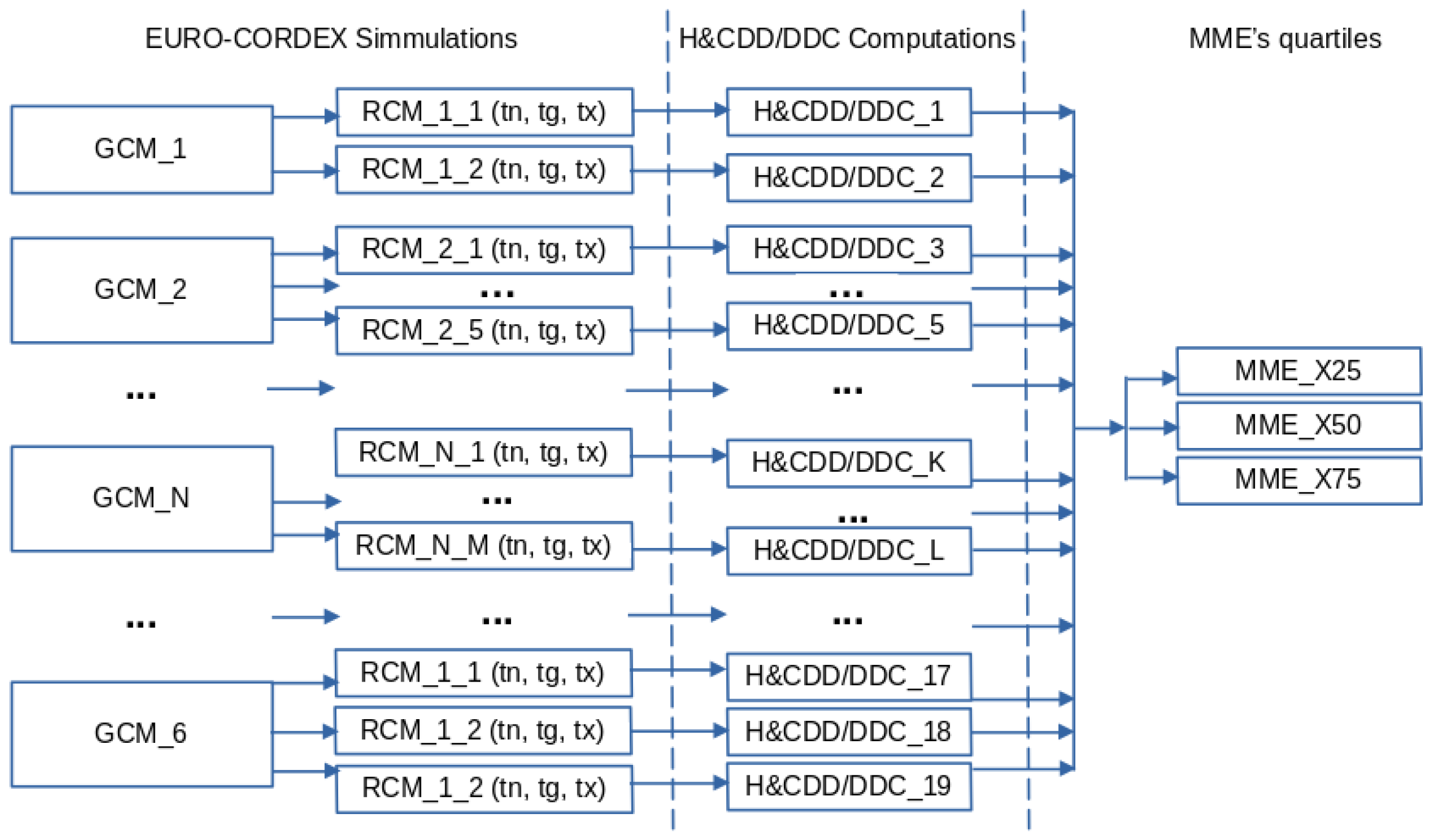
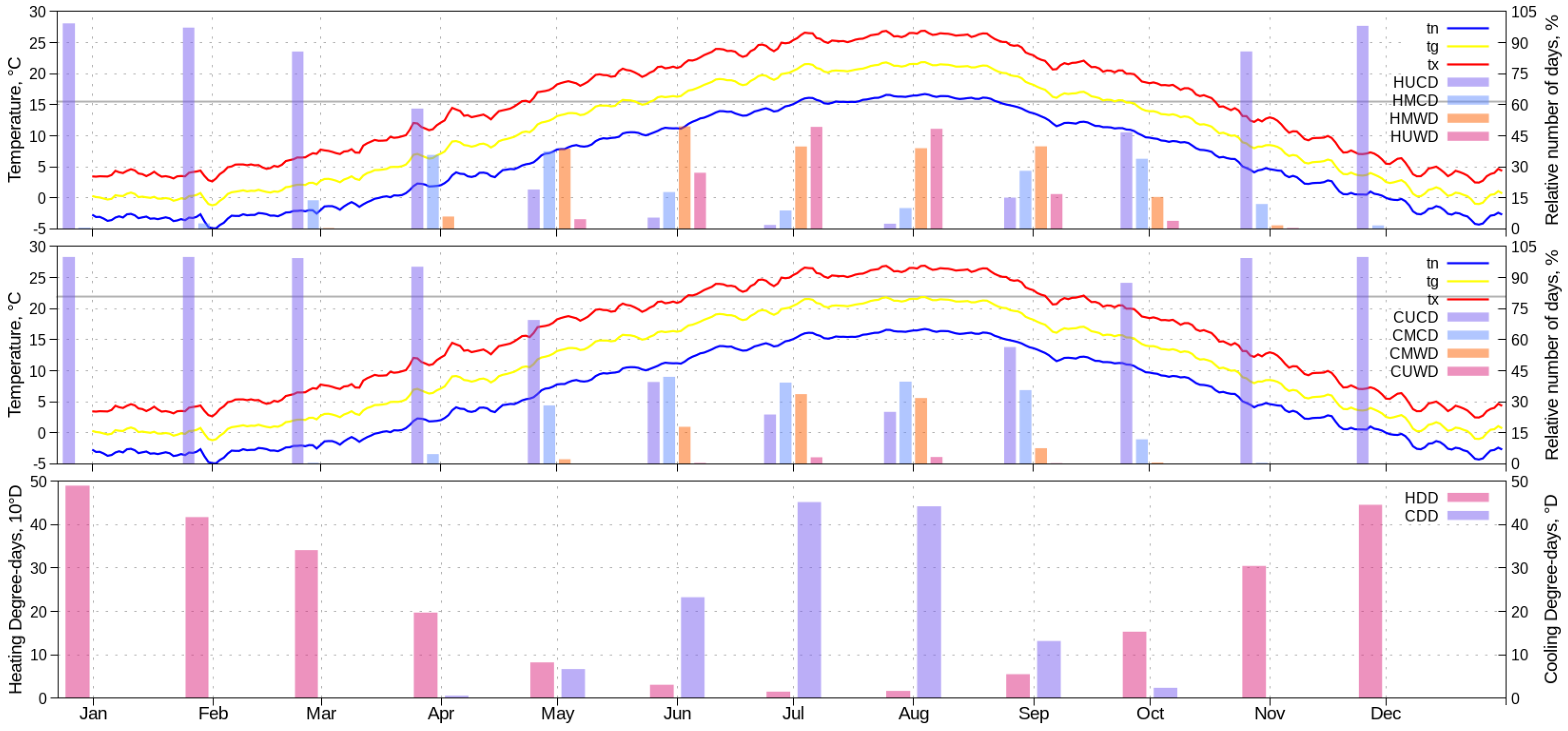
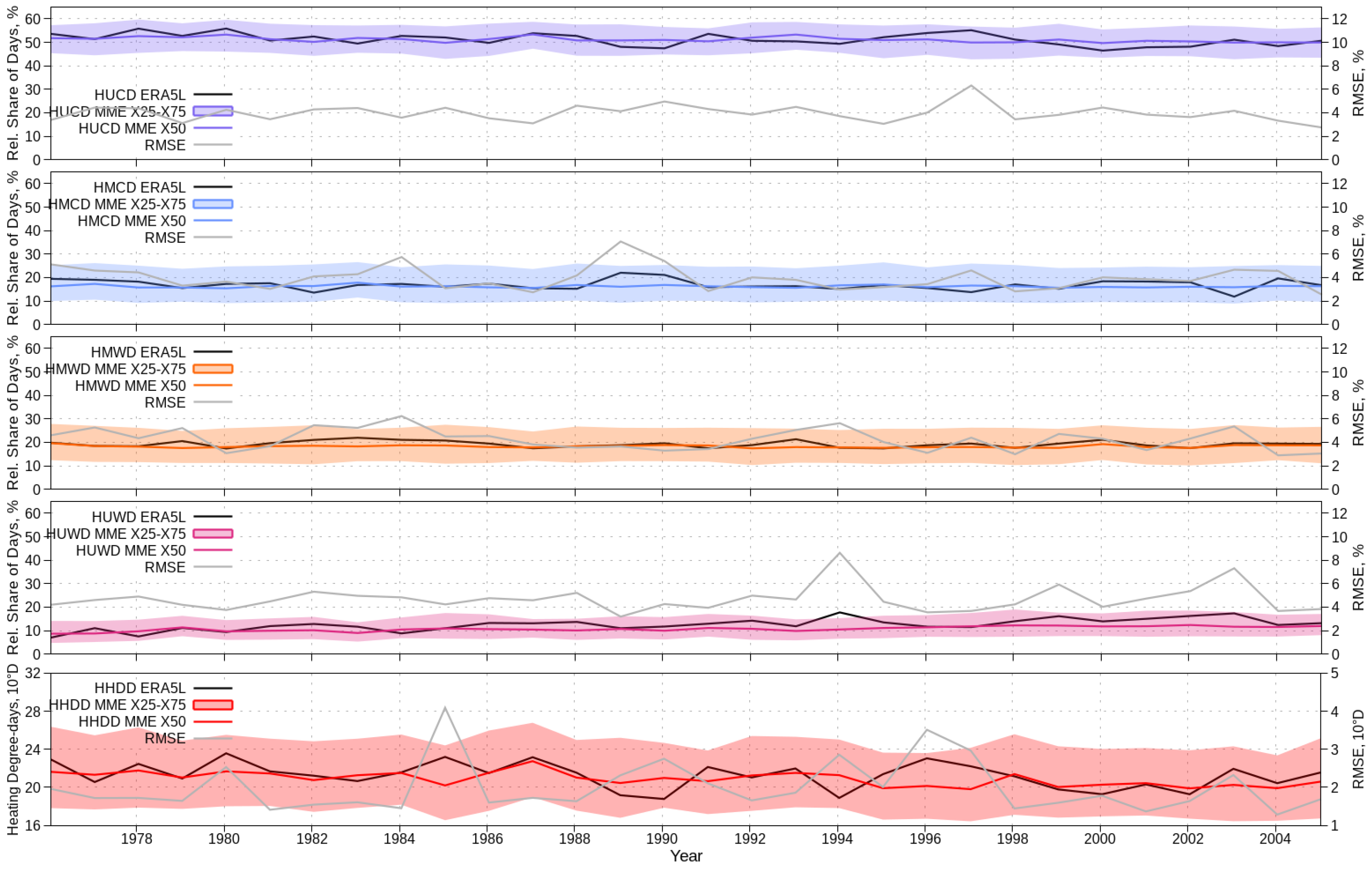
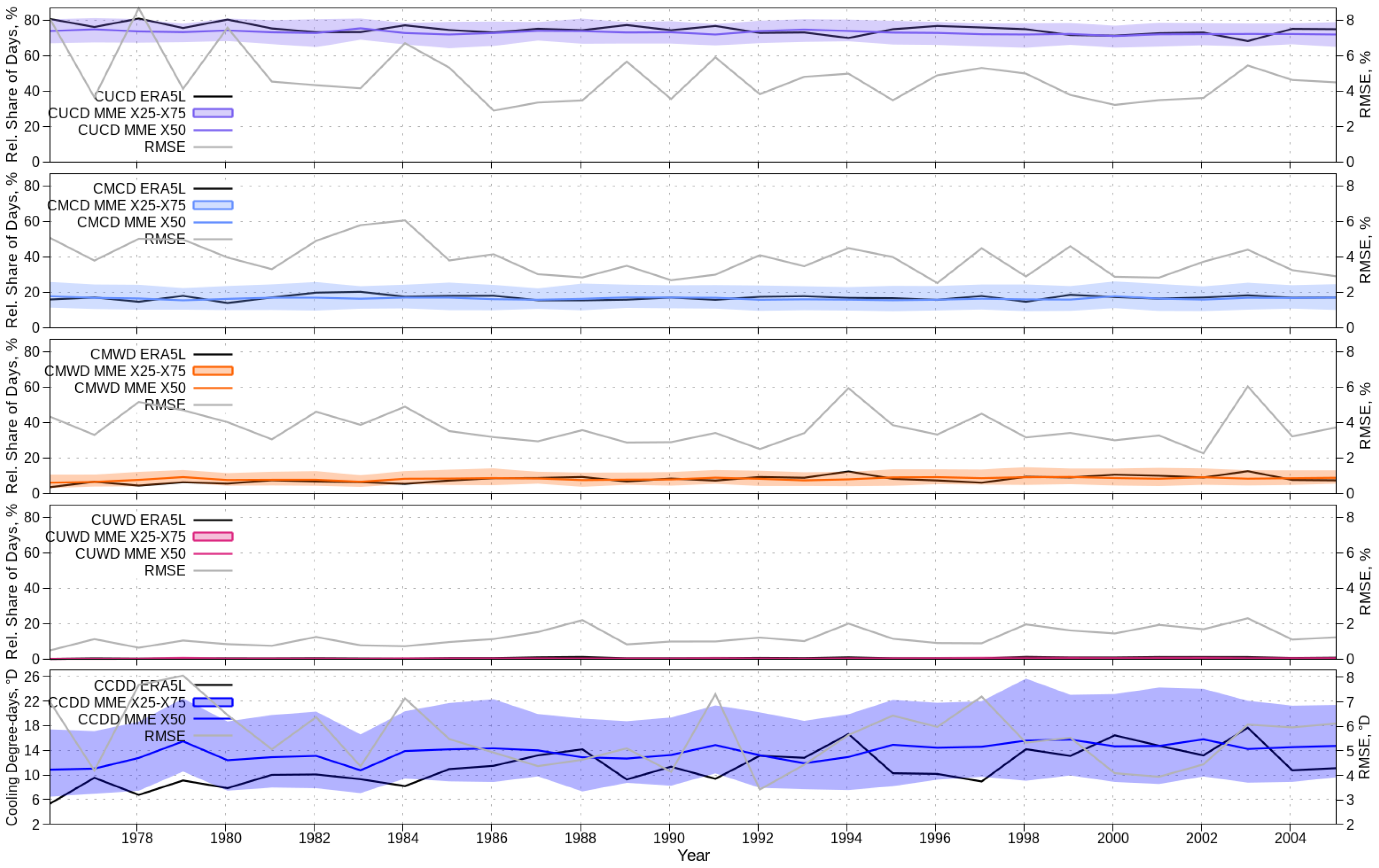
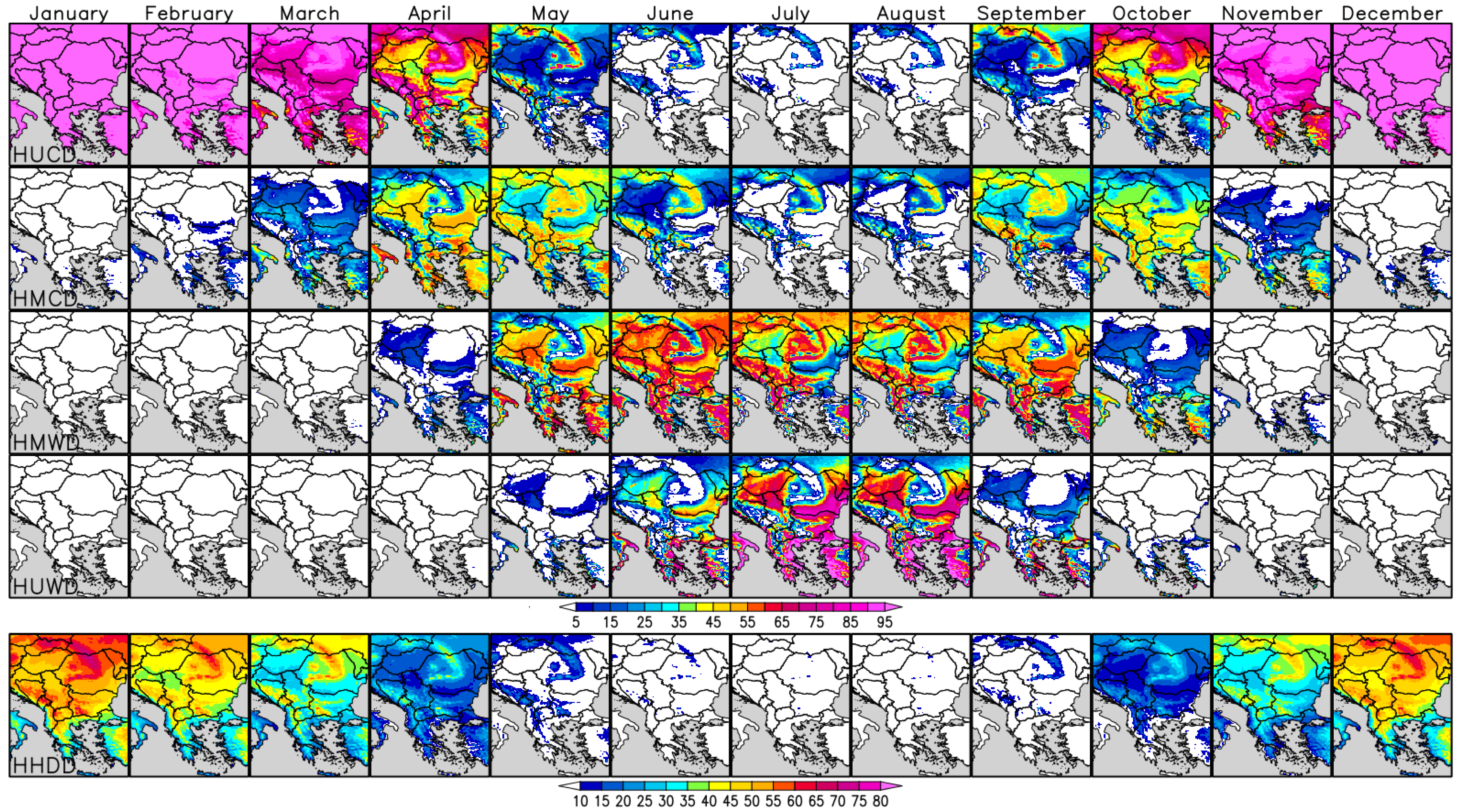

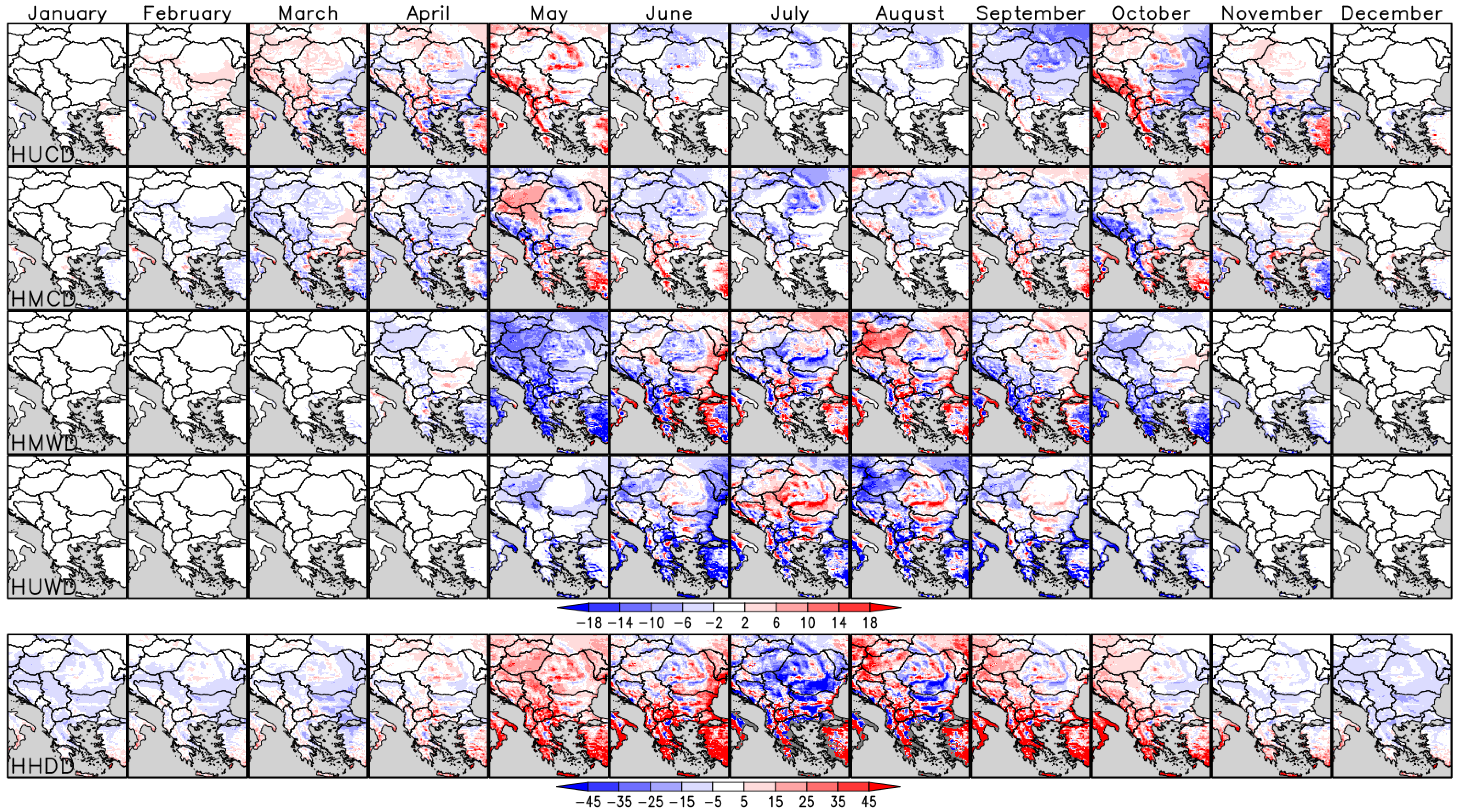

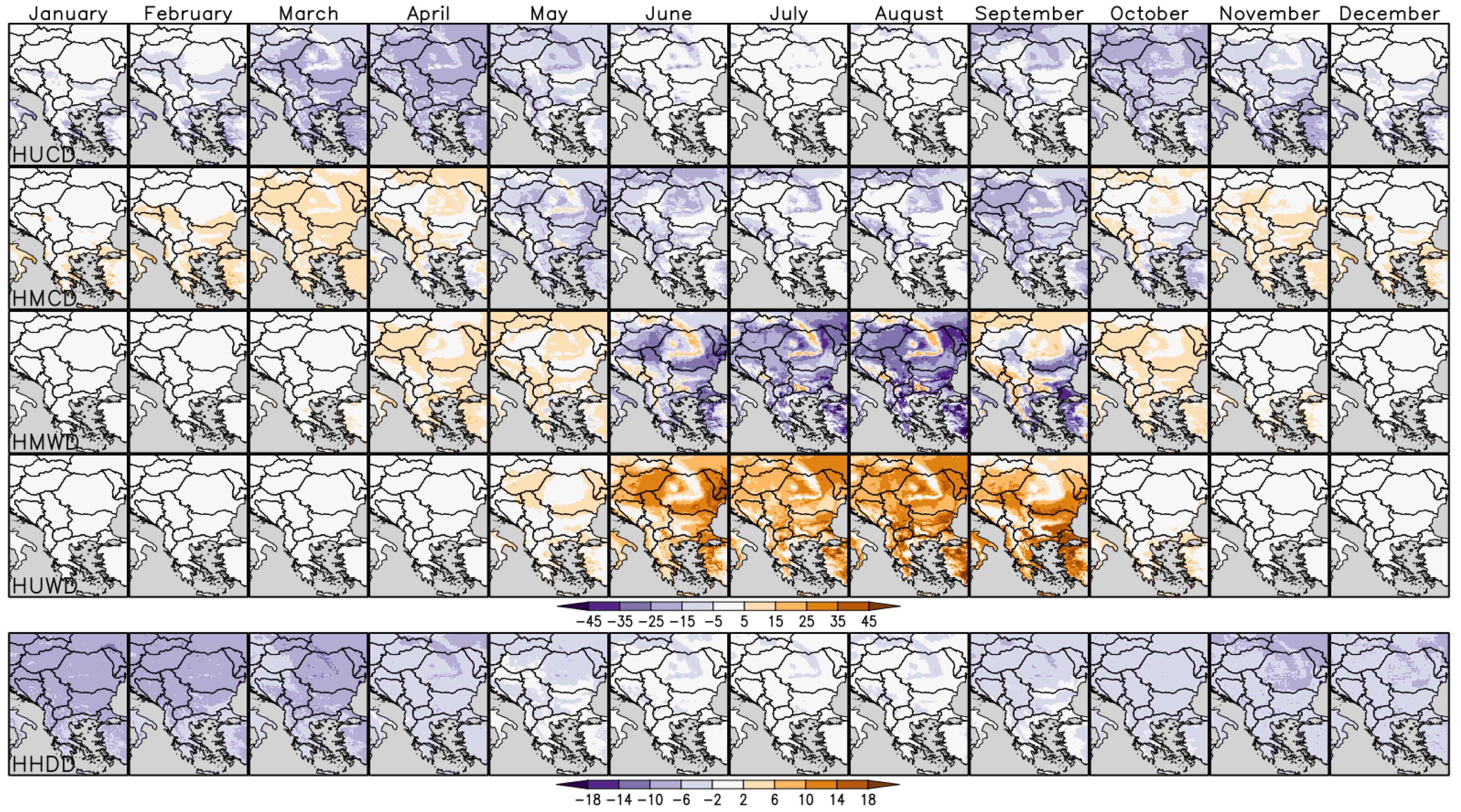
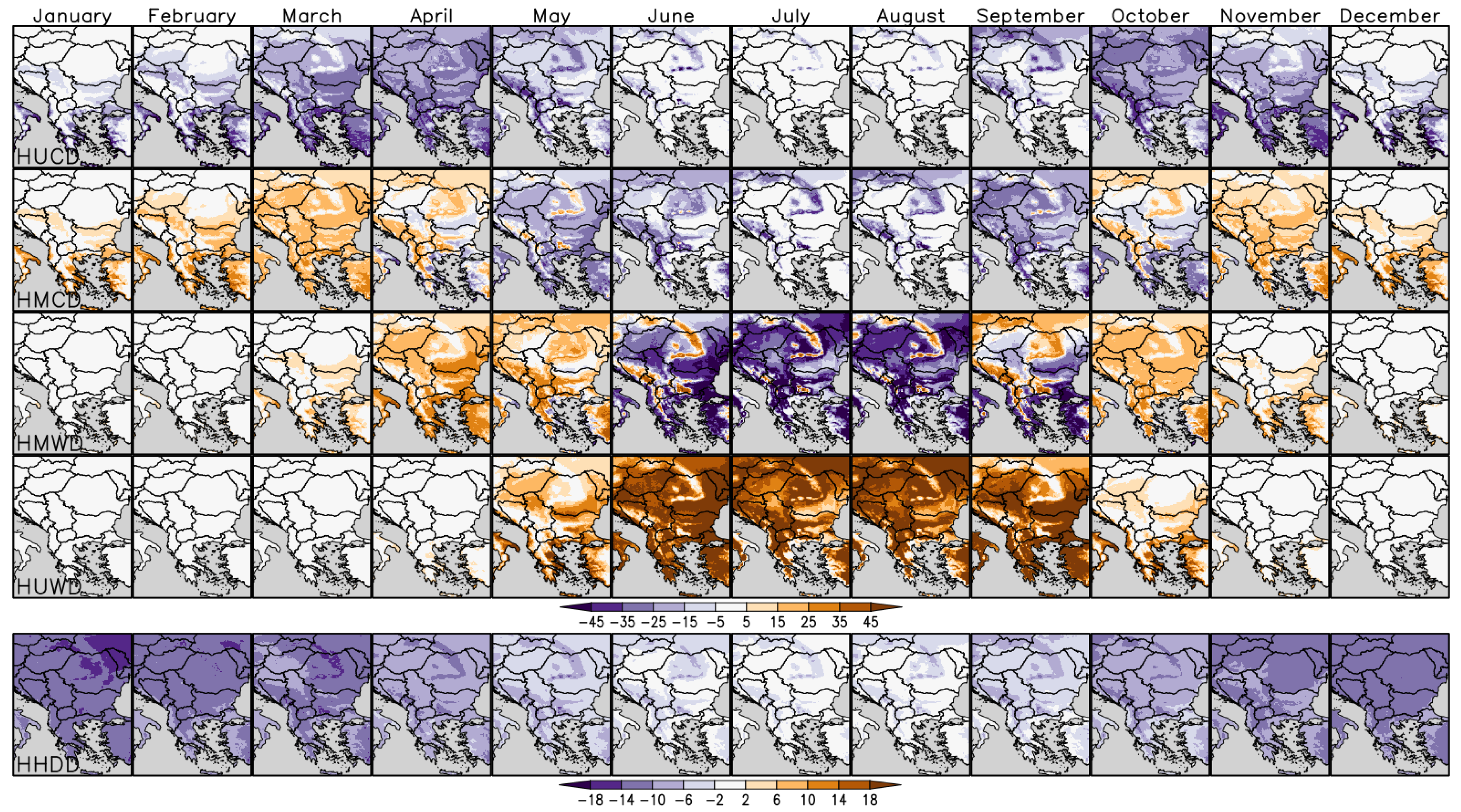

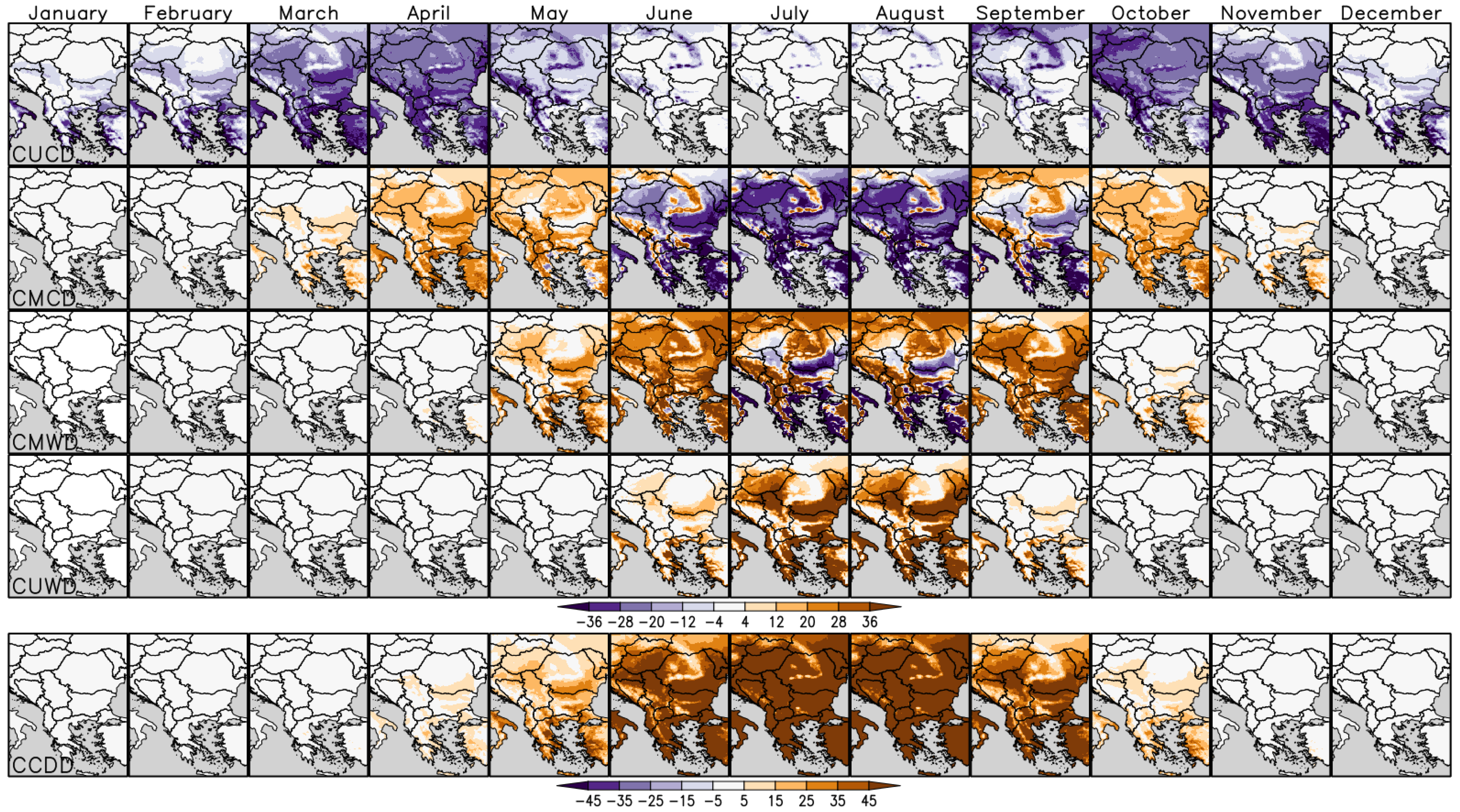


| Driving GCM/Institution, Country | RCM/Institution, Country |
|---|---|
| CNRM-CERFACS-CNRM-CM5/Meteo France, France | CNRM-ALADIN63/Meteo France, France |
| KNMI-RACMO22E/KNMI, Netherlands | |
| ICHEC-EC-EARTH/EC-EARTH Consortium | CLMcom-CCLM4-8-17/CLM Community with contributors |
| DMI-HIRHAM5/DMI, Denmark | |
| GERICS-REMO2015/GERICS, Germany | |
| KNMI-RACMO22E/KNMI, Netherlands | |
| SMHI-RCA4/SMHI, Sweden | |
| IPSL-IPSL-CM5A-MR/IPSL, France | IPSL-WRF381P/IPSL, France |
| SMHI-RCA4/SMHI, Sweden | |
| MOHC-HadGEM2-ES/MOHC, UK | CLMcom-CCLM4-8-17/CLM Community with contributors |
| DMI-HIRHAM5/DMI, Denmark | |
| GERICS-REMO2015/GERICS, Germany | |
| KNMI-RACMO22E/KNMI, Netherlands | |
| SMHI-RCA4/SMHI, Sweden | |
| MPI-M-MPI-ESM-LR/MPI-M, Germany | MPI-CSC-REMO2009/MPI-M, Germany |
| SMHI-RCA4/SMHI, Sweden | |
| NCC-NorESM1-M/NCC, Norway | DMI-HIRHAM5/DMI, Denmark |
| GERICS-REMO2015/GERICS, Germany | |
| SMHI-RCA4/SMHI, Sweden |
| Condition, Degree-Day Category | HDD= | CDD= |
|---|---|---|
| tx ≤ tb (uniformly cold day, UCD) | tb-tg | 0 (No cooling is required) |
| tg ≤ tb < tx (mostly cold day, MCD) | (tb-tn)/2-(tx-tb)/4 | (tx-tb)/4 |
| tn < tb < tg (mostly warm day, MWD) | (tb-tn)/4 | (tx-tb)/2-(tb-tn)/4 |
| tn ≥ tb (uniformly warm day, UWD) | 0 (No heating is required) | tg-tb |
Disclaimer/Publisher’s Note: The statements, opinions and data contained in all publications are solely those of the individual author(s) and contributor(s) and not of MDPI and/or the editor(s). MDPI and/or the editor(s) disclaim responsibility for any injury to people or property resulting from any ideas, methods, instructions or products referred to in the content. |
© 2025 by the authors. Licensee MDPI, Basel, Switzerland. This article is an open access article distributed under the terms and conditions of the Creative Commons Attribution (CC BY) license (https://creativecommons.org/licenses/by/4.0/).
Share and Cite
Chervenkov, H.; Slavov, K. Evaluation and Projection of Degree-Days and Degree-Days Categories in Southeast Europe Using EURO-CORDEX. Atmosphere 2025, 16, 1153. https://doi.org/10.3390/atmos16101153
Chervenkov H, Slavov K. Evaluation and Projection of Degree-Days and Degree-Days Categories in Southeast Europe Using EURO-CORDEX. Atmosphere. 2025; 16(10):1153. https://doi.org/10.3390/atmos16101153
Chicago/Turabian StyleChervenkov, Hristo, and Kiril Slavov. 2025. "Evaluation and Projection of Degree-Days and Degree-Days Categories in Southeast Europe Using EURO-CORDEX" Atmosphere 16, no. 10: 1153. https://doi.org/10.3390/atmos16101153
APA StyleChervenkov, H., & Slavov, K. (2025). Evaluation and Projection of Degree-Days and Degree-Days Categories in Southeast Europe Using EURO-CORDEX. Atmosphere, 16(10), 1153. https://doi.org/10.3390/atmos16101153






